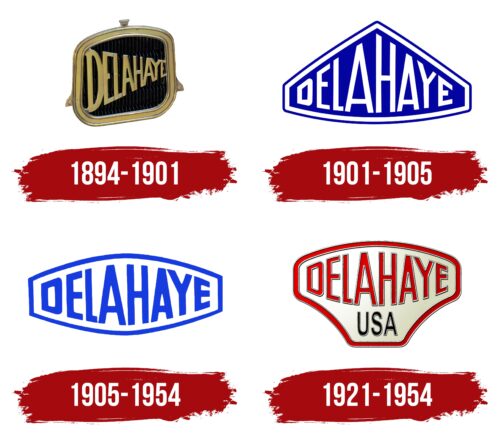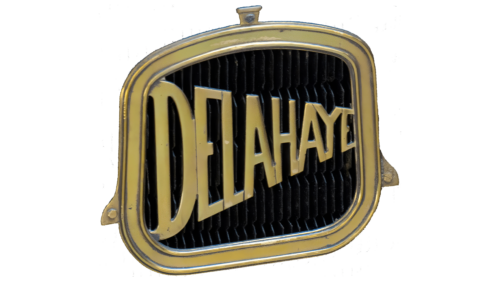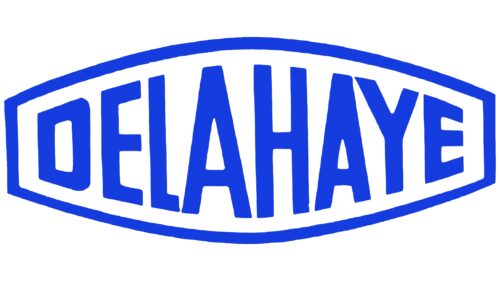The Delahaye logo demonstrates fluidity. It perfectly matches the car’s premium exterior design and high-quality technical equipment. The sleek shapes emphasize the vehicles’ speed and racing victories.
Delahaye: Brand overview
Founded in 1894 by Emile Delahaye in Tours, France, Delahaye began its journey as an automobile manufacturer, initially building engines and chassis for other automobile companies. A few years later, in 1898, the firm moved to Paris, where it began producing finished cars, such as the early Type 1 model, which featured a prominently protruding engine.
In the first two decades of the 20th century, Delahaye’s portfolio expanded from small cars called voiturettes to larger luxury cars and commercial trucks. Delahaye became famous on the racetrack, winning prestigious competitions like the Gordon Bennett Cup. This enhanced the brand’s reputation for both performance and reliability.
In the 1930s, Delahaye became a serious luxury competitor, introducing chic models such as the Type 135 coupe. These cars had an unusual body to compete with the Bugatti. However, during World War II, the brand’s success was interrupted when it shifted its focus to producing engines and cars for the French military, and regular car production was suspended.
Delahaye experienced financial difficulties in the post-war period, and its inability to finance new developments led to a gradual decline in innovation. In 1954, the company was absorbed by Hotchkiss, marking the end of the Delahaye era of automobile manufacturing.
Reflecting on sixty years of Delahaye’s existence, the brand’s production of 25,000 cars is a testament to its craftsmanship and pioneering spirit. Many of these cars are now valuable collector’s items, symbolizing a bygone era of French automotive excellence.
Delahaye’s enduring legacy, defined by its racing pedigree, technical performance, and exclusive styling, places it among the outstanding representatives of the pre-war French automobile industry. The brand’s history fascinates enthusiasts, reflecting a rich tradition that celebrates the unique combination of engineering and elegance that once distinguished Delahaye.
Meaning and History
What is Delahaye?
It is a French automobile manufacturing company known for producing luxury passenger cars and commercial vehicles. Emile Delahaye founded it and became famous for its elegant automobiles, popular among the affluent and discerning buyers of the early 20th century. The cars were known for their advanced engineering, stylish design, and participation in motorsports. Among the famous models is the Delahaye 135. Despite its prestigious reputation, the company ceased production but remains prominent in automotive history.
1894 – 1901
The first Delahaye logo featured a radiator grille, evoking the automotive industry. Black, perfectly straight plates on the logo highlighted Delahaye cars’ precise proportions and thoughtful design. Gilded frames and lettering added an element of elegance, emphasizing the prestige and luxury of the company’s cars.
The logo was slightly tilted to the right, creating an illusion of movement and dynamism with the diminishing letters of the name. The screw fastenings on the logo gave the impression that the grille had just been removed from a car, adding a sense of realism and technical accuracy.
1901 – 1905
The 1901 logo design resembled the front view of a car hood, symbolizing the company’s automotive focus. During this period, the company transitioned to the founder’s partners, sparking new development and creating the new blue-and-white 0A car design.
The logo’s pointed top conveyed the company’s drive for growth and innovation, reflecting its ambitions. The letters on the logo, echoing its shape, emphasized the functionality of Delahaye’s products and their alignment with their purpose.
1905 – 1954
The perfection of the logo’s form came with the arrival of the new designer Amédée Varlet, who brought many interesting solutions to the look of Delahaye cars. Under his leadership, the emblem gained sleekness and harmony, reflecting the company’s aim to offer the best product. Every detail of the logo shows a desire to create a true work of art that combines aesthetics and functionality.
Since 1905, each Delahaye car has featured a unique design, setting them apart from competitors. Powerful engines and impeccable quality became the brand’s hallmark. Delahaye cars provided comfort and reliability, impressing with their appearance and making them desirable for car enthusiasts. These qualities cemented Delahaye’s reputation as a manufacturer of elite and high-quality automobiles.
1921 – 1954
The Delahaye logo features a mushroom shape, giving this French car company’s emblem a distinctive and memorable look. This text-based logo uses two lines of lettering arranged at different levels for balance and appeal.
At the top, “Delahaye” is displayed in capital letters that gradually decrease in size from the center to the edges. The vibrant red color makes these geometric letters stand out. A white outline with black shadows gives the letters a three-dimensional appearance against the white background, ensuring the brand name captures attention.
Below, “USA” is indicated in flat black letters. This straightforward and bold typography adds solidity and reliability to the logo. The simplicity of this line contrasts with the more elaborate top line, creating a balanced design that highlights the brand’s heritage and international presence.
The mushroom shape of the logo sets it apart from conventional circular or square logos. This unique form adds creativity and distinguishes the brand in a crowded market. The red letters at the top are a vibrant focal point, emphasized by the three-dimensional effect. The “USA” lettering below provides a grounded and stable element, rendered in simple black.
The Delahaye logo’s unique shape, bold colors, and thoughtful typography create a striking and recognizable emblem. It reflects the brand’s innovative spirit and commitment to quality, effectively representing the company’s identity.








